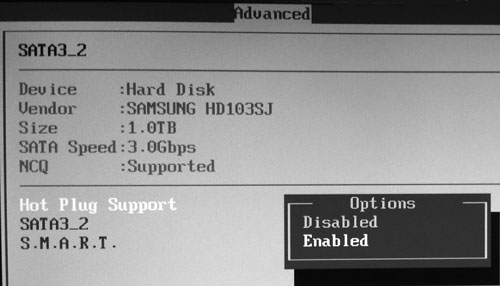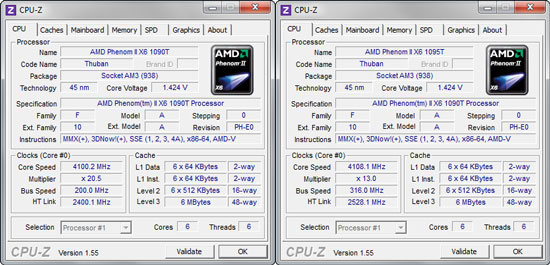ASRock 890FX Deluxe: Comprehensive Motherboard Review & Investigation of Thuban Performance Scaling
by Rajinder Gill on August 31, 2010 7:00 AM EST- Posted in
- ASRock
- AMD
- Motherboards
- 890FX
The Deluxe 4’s AMI-based BIOS is pretty straight-forward. Almost all overclocking related changes are made under “OC Tweaker” tab, and enthusiasts will feel right at home with familiar labels. We suggest you take a look at the Gallery for the individual pages of the Deluxe 4’s BIOS.
A notable item in the BIOS is the way ASRock manages SB850’s six SATA 6.0 Gbps ports as well as two of the Marvell’s. We’ve already commended how the Deluxe 4 matches the port numbers in the BIOS and on the PCB. Furthermore, ASRock somehow found a seamless way to make hot-plug/hot-swap to work from the BIOS, both for Windows native AHCI drivers and for AMD’s AHCI drivers. Windows and AHCI have had a rather tricky history, and although Windows 7 is miles ahead of previous iterations of Windows, we still run into trouble getting hot-plug function properly on occasions. Those who have attempted to take advantage of AHCI’s hot-plug/hot-swap might remember “Safely Remove Hardware” notification disappearing, or not showing up at all when it should. This often occurs upon installation of chipset drivers from AMD and Intel but Windows native AHCI drivers don’t seem to be immune to it, either.
The Deluxe 4 lets users handle this in the BIOS’s Storage Configuration section. Once AHCI is enabled, users can select individual drives to enable hot-swap/hot-plug. This worked for us with Microsoft’s AHCI drivers, AMD’s AHCI drivers, and with the “F8” method by loading the AHCI drivers at the time of OS installation. We are not sure how ASRock is doing this but it worked throughout our testing with both SSDs and mechanical drives, so we have no complaints.


Our retail 1090T CPU reached its maximum overclock of 4.10 GHz on the Deluxe 4 at 1.42V actual vCore using conventional air-cooling. Having a Black-Edition CPU makes overclocking easy on most boards if you simply want to take advantage of the unlocked multiplier. On the 890FX Deluxe 4 or any other board, our retail 1090T’s overclocking has been limited by heat for the most part. For maximum HTT overclocking, we lowered multiplier as low as x10 and reached 316 HTT, which coincidently got us to the same maximum CPU overclock of 4.10 GHz using x13 multiplier. For S3 Sleep/resume to work correctly the HTT had to stay at or below 290 HTT. Not bad, but not great. That should give enough room for the 1055T CPU (x14 multi) to reach its maximum potential, but it might not be enough for CPUs with lower multipliers. (There are rumors of more X6 CPUs from AMD later this year).

In general, the board tends to overvolt vCore under load by 0.04V with ensuing 0.02V or so vDroop. For example, when we set the vCore to 1.40V, the CPU received about 1.44V when the load is light (e.g. a single Super Pi instance), but when all 6 cores were loaded fully we measured about 1.42V. Once the CPU was idle and C1E kicked in, the board lowered the vCore below 1.20V accordingly.
Unfortunately, we found neither the BIOS reading nor Windows-based software including ASRock’s own OC Tuner utility correctly informs us of the actual amount of current the CPU receives. To make matters worse, the BIOS labels referring to vDroop control are highly misleading. The BIOS offers four options under “Load-line Calibration” section: Auto, Normal, Slight, Disable. We advise you to stick to “Normal” if you overclock, and to “Auto” for stock operation with TurboCore enabled, since the other two options will take your CPU to a voltage rollercoaster. “Normal” was also the most predictive of all as we exampled above, so without reliable software readings it is the only option we would take when overclocking an X6 CPU.
Memory overclocking on the Deluxe 4 was disappointing compared to our experience on ASUS M4A89GTD Pro/USB3. First and foremost, we warn you again the board overvolts memory by 0.05~0.06V so you should always subtract what you set in the BIOS by that amount. We set out to find out maximum stable frequency using 4 x 2GB and reasonable timings, and settled at DDR3-1666/7-8-7-1T at vDIMM set to 1.62V actual (1.57V in the BIOS). It was possible to run DDR3-1666/7-7-7-1T but it required us to set 1.62V in the BIOS, resulting in actual 1.67~1.68 vDIMM. The maximum frequency we reached with complete stability on 8GB configuration was DDR3-1800/8-9-8-2T. 4GB configuration with two DIMMs did fare slightly better, reaching stable DDR3-1800/7-8-7-1T. We were able to finish some tests @DDR3-2000/8-9-8-1T (1.67V actual), but it was nowhere near fully stable to finish our entire stressing test suit.
Overall, we feel the Deluxe 4’s memory overclocking is rather limited; the BIOS provides no control options for certain sub-timings that require adjustment as memory frequency is increased. This is obviously a matter of BIOS finesse, since we were easily able to achieve DDR3-2066/8-9-8-1T on the ASUS M4A89GTD USB3/PRO, using the same 4x2GB PSC kits. We hope ASRock will improve in this regard in the future BIOS releases, so that users will have more freedom exploring the limits of their hardware.
















42 Comments
View All Comments
jonup - Tuesday, August 31, 2010 - link
Very impressed to see this approach to your testing. I hete when reading an MB reveiw and reach the benchmark section. Same chipsets tend to perform the same. A guess this would be an one-off since in the next review it will be redundant.vol7ron - Tuesday, August 31, 2010 - link
agreed, nice review.Finally - Tuesday, August 31, 2010 - link
I must say that this review was nice to have, I'm much more interested in the 870 Chipset.It's almost identical, except the support of Crossfire, which I have no use for.
RequiemsAllure - Wednesday, September 1, 2010 - link
ahh, but on the ASRock 870 extreme 3 Crossfire is supported.SpaceRanger - Tuesday, August 31, 2010 - link
In the article:USB 3.0 Performance
We use Acronis TrueImage Home (v. 10) to make a backup of our installation drive to an external SATA 3.0 Gbps drive via USB 3.0 and compare it with USB 2.0 and SATA 3.0 Gbps transfers. The total data backed up is approximately 20 GB. We could not complete the backup on the 890GTD Pro/USB3 in a consistent manner.
My Question:
Why were you not able to complete the backup on the 890GTD Pro/USB3? At the conclusion you state :
Is it worth $180 when ASUS 890GTD Pro/USB3 is $30 less? We think the difference largely comes down to the board’s selection of components.
I would call not being able to do a simple backup with the 890GTD enough of a showstopper to not even consider the board. Am I missing something here?
semo - Tuesday, August 31, 2010 - link
I'm also wondering about the SATA3 performance. An issue was identified here on AT with the new 8xx chipset earlier which slowed down SSDs considerably compared to ICH10 controllers. Has this been fixed yet?Kane Y. Jeong - Tuesday, August 31, 2010 - link
Hi,Please check Raja's ASUS M4A89GTD Pro/USB3 review here.
http://www.anandtech.com/show/2959
We purchased another retail M4A89GTD Pro/USB3 off the shelf, and still ran into inconsistent USB 3.0 performance. Sometimes the drives lost connections, and Acronis reported error in the middle of backup process. Success ratio to complete the backup was about 30~40%. An alternative would be to purchase M4A89GTD Pro (not Pro/USB3) for $10 less and go with an add-in card. We did not experience this issue on ASRock 890FX Deluxe 4.
SpaceRanger - Tuesday, August 31, 2010 - link
Thank you for the response. So you're advising getting the Pro (not Pro/USB3) instead of the 890FX? Cause Raja's findings would be enough for me to not want to get it.nbjknk - Thursday, November 25, 2010 - link
Dear customers, thank you for your support of our company.
Here, there's good news to tell you: The company recently
launched a number of new fashion items! ! Fashionable
and welcome everyone to come buy. If necessary, please$$$$$$$$$$__$$$_$$$$$$$$$$$
http://www.vipshops.org
$$_____$$$_$$$_________$$$
$$$_____$$$_$$$______ $$$
$$$ ____$$$_ $$$_____ $$$
$$$$$$$$$$__$$$____$$$
$$$_____$$$_$$$___$$$
$$$_____$$$_$$$__$$$
$$$$$$$$$$$_$$$_$$$
$$$$$$$$$$__$$$_$$$$$$$$$$$$ !::!
http://www.vipshops.org
Thursday, 21 October 2010 at 9:48 PM
optarix12 - Tuesday, August 31, 2010 - link
This is a very nice writeup and relevant to my interests to boot. Thank you for the concise article Kane. Oh, and if you ever figure out why you saw the inexplicable results you should do a part 2!